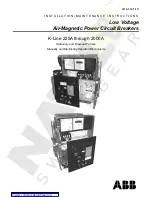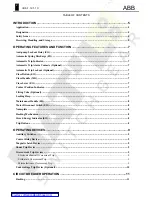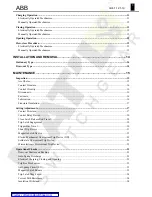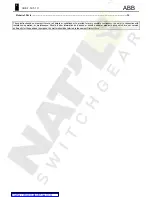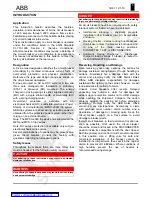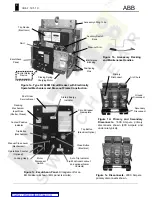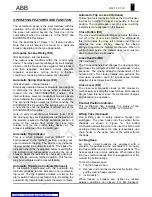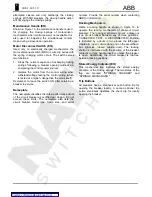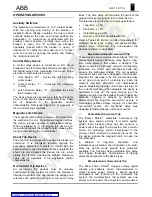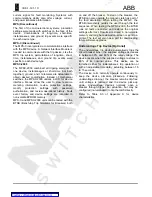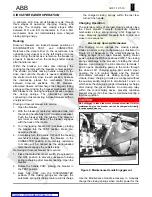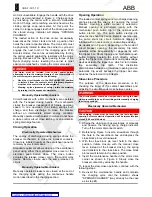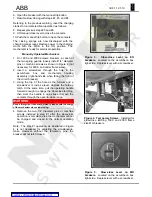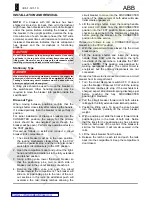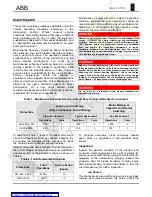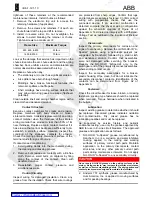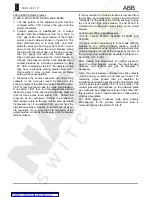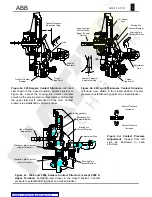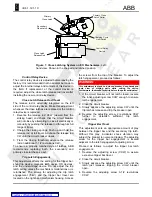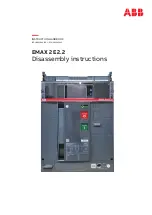
IB 6.1.12.1-1C
5
ABB
INTRODUCTION
Application
This instruction bulletin describes the features,
operation, and maintenance of K-Line circuit breakers
of 225 ampere through 2000 ampere frame sizes.
Familiarize personnel with this bulletin before placing
any circuit breakers into service.
These instructions apply to circuit breakers operated
under the conditions listed in the ANSI Standard
C37.13-1990 Section 2 (Service Conditions).
Abnormal service conditions may require a derating of
the circuit breaker or a modification to its application.
For issues not addressed in this bulletin, contact the
factory as indicated on the rear cover.
Designation
A K-Line type designation identifies the circuit breaker
accordingly by its rated continuous current, form of
overcurrent protection, and physical construction.
Reference the type and design ratings as shown on
the circuit breaker nameplate.
K-Lines are used on AC and DC systems in two and
three pole arrangements. Installation is stationary
(STAT) or draw-out (DO) mounted. The energy
charged in closing springs is either supplied manually
(MO) with a single stroke handle, or electrically (EO)
with a spring charging motor.
Overcurrent protection is available with an
electromechanical (OD), solid-state electronic (Power
Shield), or microelectronic (MPSC-2000) trip system.
ABB trip systems are direct acting; actuating power is
obtained from the protected power system rather than
relying on an external source.
Note: The MPSC-2000 trip device has superceded the
MPS and MPS-C trip devices.
Note: DC service protection is available only with an
electromechanical trip system.
Several combinations of options may be present on a
given circuit breaker. Consult the factory with
questions regarding non-standard options.
Safety Issues
Throughout the manual, there are three terms that
must be heeded, for the following safety reasons:
CAUTION
Not adhering to these instructions may result in equipment
damage or malfunction.
WARNING
Not adhering to these instructions may result in serious injury
and equipment damage.
DANGER
Not adhering to these instructions may result in life threatening
injury and permanent equipment damage.
All circuit breakers have been equipped with safety
interlock systems that must never be defeated:
•
Interference Blocking
– physically prevents
installation of a breaker into an incompatible
enclosure.
•
Racking Shutter
– denies racking handle access
to a breaker unless the breaker is both open and
in one of the three racking positions:
CONNECTED, TEST, or DISCONNECTED.
•
Automatic Spring Discharge
– discharges
charged closing springs if breaker is racked to
the DISCONNECTED position.
Receiving, Handling, and Storage
Upon receiving your order, examine the cartons for
damage sustained during transit. If rough handling is
evident, immediately file a damage claim with the
carrier and promptly notify the ABB District Sales
Office. ABB disclaims responsibility for damages
sustained after delivery to the carrier; however, we will
lend assistance if notified of a claim.
Unpack circuit breakers after receipt. Delayed
unpacking may hamper a claim for damages not
evident upon receipt. Be careful not to inflict damage
while opening the shipment. Compare the carton
contents against the packing list before discarding
packaging. Promptly notify the ABB Sales Office
concerning any discrepancies. Accompany a claim
with purchase order number, carton number, and a
description of damaged or missing parts. Keep the
circuit breaker upright on a flat surface to avoid
damage to breaker parts.
Install circuit breakers in their permanent location as
soon as possible. Until used, the circuit breaker
should be stored and locked in the DISCONNECTED
position inside its compartment with the door closed.
Both the primary and control circuits are disconnected
in this position. Use a lifting yoke for safe and
convenient installation. If the breaker cannot be
installed in its compartment, then seal it in the original
carton to prevent dirt infiltration. Where conditions of
high humidity prevail, the use of heaters is
recommended during storage.

